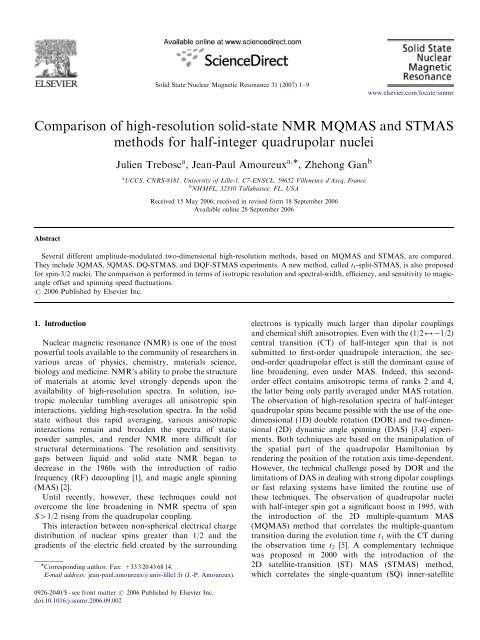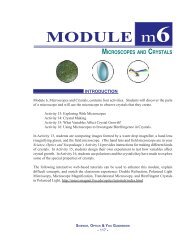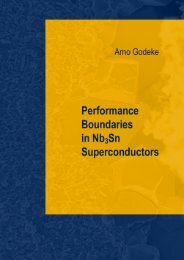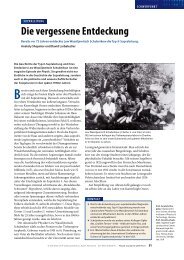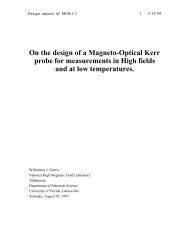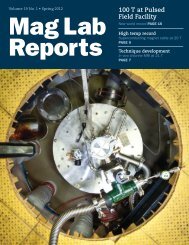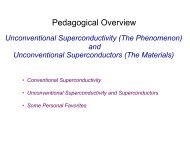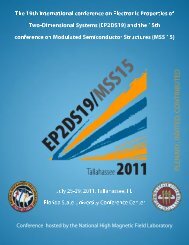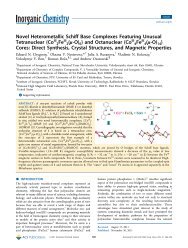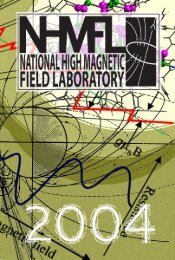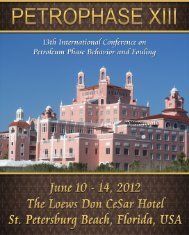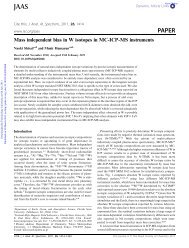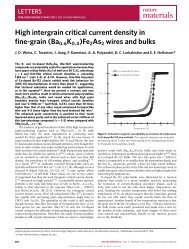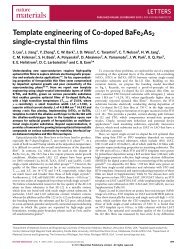read online - National High Magnetic Field Laboratory
read online - National High Magnetic Field Laboratory
read online - National High Magnetic Field Laboratory
You also want an ePaper? Increase the reach of your titles
YUMPU automatically turns print PDFs into web optimized ePapers that Google loves.
ARTICLE IN PRESS<br />
Solid State Nuclear <strong>Magnetic</strong> Resonance 31 (2007) 1–9<br />
www.elsevier.com/locate/ssnmr<br />
Comparison of high-resolution solid-state NMR MQMAS and STMAS<br />
methods for half-integer quadrupolar nuclei<br />
Julien Trebosc a , Jean-Paul Amoureux a, , Zhehong Gan b<br />
a UCCS, CNRS-8181, University of Lille-1, C7-ENSCL, 59652 Villeneuve d’Ascq, France<br />
b NHMFL, 32310 Tallahassee, FL, USA<br />
Received 15 May 2006; received in revised form 18 September 2006<br />
Available <strong>online</strong> 28 September 2006<br />
Abstract<br />
Several different amplitude-modulated two-dimensional high-resolution methods, based on MQMAS and STMAS, are compared.<br />
They include 3QMAS, 5QMAS, DQ-STMAS, and DQF-STMAS experiments. A new method, called t 1 -split-STMAS, is also proposed<br />
for spin-3/2 nuclei. The comparison is performed in terms of isotropic resolution and spectral-width, efficiency, and sensitivity to magicangle<br />
offset and spinning speed fluctuations.<br />
r 2006 Published by Elsevier Inc.<br />
1. Introduction<br />
Nuclear magnetic resonance (NMR) is one of the most<br />
powerful tools available to the community of researchers in<br />
various areas of physics, chemistry, materials science,<br />
biology and medicine. NMR’s ability to probe the structure<br />
of materials at atomic level strongly depends upon the<br />
availability of high-resolution spectra. In solution, isotropic<br />
molecular tumbling averages all anisotropic spin<br />
interactions, yielding high-resolution spectra. In the solid<br />
state without this rapid averaging, various anisotropic<br />
interactions remain and broaden the spectra of static<br />
powder samples, and render NMR more difficult for<br />
structural determinations. The resolution and sensitivity<br />
gaps between liquid and solid state NMR began to<br />
decrease in the 1960s with the introduction of radio<br />
frequency (RF) decoupling [1], and magic angle spinning<br />
(MAS) [2].<br />
Until recently, however, these techniques could not<br />
overcome the line broadening in NMR spectra of spin<br />
S41/2 rising from the quadrupolar coupling.<br />
This interaction between non-spherical electrical charge<br />
distribution of nuclear spins greater than 1/2 and the<br />
gradients of the electric field created by the surrounding<br />
Corresponding author. Fax: +33 3 20 43 68 14.<br />
E-mail address: jean-paul.amoureux@univ-lille1.fr (J.-P. Amoureux).<br />
electrons is typically much larger than dipolar couplings<br />
and chemical shift anisotropies. Even with the (1/22 1/2)<br />
central transition (CT) of half-integer spin that is not<br />
submitted to first-order quadrupole interaction, the second-order<br />
quadrupolar effect is still the dominant cause of<br />
line broadening, even under MAS. Indeed, this secondorder<br />
effect contains anisotropic terms of ranks 2 and 4,<br />
the latter being only partly averaged under MAS rotation.<br />
The observation of high-resolution spectra of half-integer<br />
quadrupolar spins became possible with the use of the onedimensional<br />
(1D) double rotation (DOR) and two-dimensional<br />
(2D) dynamic angle spinning (DAS) [3,4] experiments.<br />
Both techniques are based on the manipulation of<br />
the spatial part of the quadrupolar Hamiltonian by<br />
rendering the position of the rotation axis time-dependent.<br />
However, the technical challenge posed by DOR and the<br />
limitations of DAS in dealing with strong dipolar couplings<br />
or fast relaxing systems have limited the routine use of<br />
these techniques. The observation of quadrupolar nuclei<br />
with half-integer spin got a significant boost in 1995, with<br />
the introduction of the 2D multiple-quantum MAS<br />
(MQMAS) method that correlates the multiple-quantum<br />
transition during the evolution time t 1 with the CT during<br />
the observation time t 2 [5]. A complementary technique<br />
was proposed in 2000 with the introduction of the<br />
2D satellite-transition (ST) MAS (STMAS) method,<br />
which correlates the single-quantum (SQ) inner-satellite<br />
0926-2040/$ - see front matter r 2006 Published by Elsevier Inc.<br />
doi:10.1016/j.ssnmr.2006.09.002
2<br />
ARTICLE IN PRESS<br />
J. Trebosc et al. / Solid State Nuclear <strong>Magnetic</strong> Resonance 31 (2007) 1–9<br />
transitions (ST) during t 1 with the CT during t 2 [6]. For all<br />
crystallites, the three 2D methods (DAS, MQMAS and<br />
STMAS) utilize mirror images during t 1 and t 2 , which<br />
refocus the second-order quadrupole dephasings along a<br />
unique axis, thus leading to observation of high-resolution<br />
2D spectra. Recently, the use of double-quantum (DQ) ST<br />
coherences was introduced with the STMAS method. With<br />
a CT selective soft p pulse, SQ inner-STs can be transferred<br />
efficiently to DQ STs and vice versa. The experiment was<br />
originally developed for suppressing undesired CT–CT<br />
diagonal peaks by double-quantum filtering (DQF) [7].<br />
Two options are available depending on where to put the t 1<br />
period, with SQ or DQ evolution, namely DQF-STMAS<br />
and DQ-STMAS [7]. Both experiments yield high resolution<br />
spectra and their isotropic peak positions are identical<br />
in a unified representation [8,9]. In this article, we would<br />
like to compare the important aspects of efficiencies,<br />
resolutions, isotropic spectral widths, and sensitivities to<br />
spinning speed fluctuations and magic-angle offset between<br />
the two methods, along with MQMAS. We also propose a<br />
hybrid version of DQ-STMAS and DQF-STMAS, called<br />
t 1 -split-STMAS, for obtaining a simultaneous refocusing of<br />
signals arising through both symmetrical pathways used<br />
during t 1 in an amplitude-modulated experiment.<br />
2. Mathematical description<br />
2.1. Quadrupole frequency<br />
Under fast spinning speed, the quadrupole frequency<br />
between Zeeman states m and n of the p-quantum (pQ:<br />
p ¼ n–m) level coherence, can be written as [10–12]<br />
n m;n ¼ n 1 m;n þ n2 m;n þ n3 m;n þ , (1)<br />
where n 1 m;n , n2 m;n , and n3 m;n are the first-, second-, and thirdorder<br />
associated quadrupole frequencies, respectively:<br />
n 1 m;n ¼ n Qðm 2 n 2 Þf3 cos 2 b R 1<br />
þ Z Q sin 2 b R cos 2a R gd 2 00 ðwÞ=4,<br />
ð2Þ<br />
n 2 m;n ¼ n2 Q =5040n 0<br />
X<br />
l¼0;2;4<br />
B l ða R ; b R ; Z Q ÞC l ðS; m; nÞd l 00ðwÞ, (3)<br />
n 3 m;n ¼ X<br />
n3 Q =27n2 0 D l ða R ; b R ; Z Q ÞE l ðS; m 2 ; n 2 Þd l 00 ðwÞ,<br />
l¼0;2;4;6<br />
(4)<br />
where S is the spin value, n 0 the Larmor frequency,<br />
n Q ¼ 3C Q /2S(2S 1) the quadrupole frequency, C Q ¼ e 2 qQ<br />
the quadrupole coupling constant, Z Q the quadrupole<br />
asymmetry parameter, w the angle between the rotation<br />
axis and the magnetic field, and d 2 00 ðwÞ, d4 00 ðwÞ and d6 00ðwÞ the<br />
Legendre polynomials of order 2, 4 and 6, respectively<br />
(d 0 00ðwÞ ¼1):<br />
d 2 00 ðwÞ ¼ð3 cos2 w 1Þ=2,<br />
d 4 00 ðwÞ ¼ð35 cos4 w<br />
30 cos 2 w þ 3Þ=8,<br />
d 6 00 ðwÞ ¼ð231 cos6 w 315 cos 4 w þ 105 cos 2 w 5Þ=16, (5)<br />
with<br />
B 0 ðZ Q Þ¼ 56ð3 þ Z 2 QÞ, (6)<br />
B 2 ða R ; b R ; Z Q Þ¼B 2 0 d2 00 ðb RÞþ2B 2 2 cos 2a Rd 2 20 ðb RÞ, (7)<br />
B 4 ða R ; b R ; Z Q Þ¼B 4 0 d4 00 ðb RÞþ2B 4 2 cos 2a Rd 4 20 ðb RÞ<br />
þ 2B 4 4 cos 4a Rd 4 40 ðb RÞ,<br />
ð8Þ<br />
B 2 0 ¼ 20ðZ2 Q 3Þ; B 2 2 ¼ 20Z p ffiffi<br />
Q 6 ; B<br />
4<br />
0 ¼ 2ð18 þ Z 2 Q Þ;<br />
B 4 2 ¼ 6Z p ffiffiffiffiffi p ffiffiffiffiffi<br />
Q 10 ; B<br />
4<br />
4 ¼ Z 2 Q 70 , ð9Þ<br />
with<br />
C l ðS; m; nÞ ¼C l ðS; mÞ C l ðS; nÞ and<br />
E l ðS; m 2 ; n 2 Þ¼E l ðS; m 2 Þ E l ðS; n 2 Þ, (10)<br />
C 0 ðS; mÞ ¼m½SðS þ 1Þ 3m 2 Š, (11)<br />
C 2 ðS; mÞ ¼m½8SðS þ 1Þ 12m 2 3Š, (12)<br />
C 4 ðS; mÞ ¼m½18SðS þ 1Þ 34m 2 5Š, (13)<br />
with<br />
D l ða R ; b R ; Z Q Þ¼c l0 ðZ Q Þd l 00 ðb RÞ<br />
þ 2<br />
X<br />
c lk ðZ Q Þ cos ka R d l k0 ðb RÞ,<br />
k¼2;4;...;l<br />
ð14Þ<br />
E l ðS; m 2 Þ¼a l p a ðS; m 2 Þþb l p b ðS; m 2 Þþc l p c ðS; m 2 Þ (15)<br />
(a R , b R ) polar angles describe the rotation axis with respect<br />
to the quadrupole interaction, and d l k0 ðb RÞ are reduced<br />
Wigner matrices of order l, respectively. Parameters a l , b l ,<br />
c l , and c lk (Z Q ), as well as p a , p b ,andp c even functions of the<br />
m Zeeman state have been defined in [12].<br />
2.2. <strong>High</strong>-resolution 2D methods<br />
Actually, most of the high-resolution experiments are<br />
performed under MAS. This means that, in case of small or<br />
medium quadrupole interactions, only zeroth- and fourthrank<br />
contributions of the second-order quadrupole interactions<br />
(terms with l ¼ 0, 4 in Eq. (3)) are then involved in<br />
the quadrupole frequency. Moreover, most of the times,<br />
only CT signal is used during the acquisition period,<br />
and this is the case of all MQ/ST-MAS methods. Their<br />
2D high-resolution spectra, can thus be obtained by<br />
selecting during t 1 coherences that cancel simultaneously<br />
for all crystallites, at t 2e ¼ Rt 1 , the second-order CT<br />
quadrupole anisotropic dephasing that occurs during<br />
observation. This canceling is always possible as long as<br />
the coherence selected during t 1 presents a C 4 (S, m, n) term<br />
of opposite sign with respect to that of the CT ( 1Q:<br />
m ¼ n ¼ 1/2):<br />
R ¼ C 4 ðS; m; nÞ=C 4 ðS; 1=2; 1=2Þ40. (16)
ARTICLE IN PRESS<br />
J. Trebosc et al. / Solid State Nuclear <strong>Magnetic</strong> Resonance 31 (2007) 1–9 3<br />
In MQMAS, symmetrical Zeeman states (m ¼ n ¼ 7<br />
3/2, 75/2, 77/2, or 79/2), are used [8]. In STMAS, there<br />
are many possible non-symmetrical (m, n) ST couples [13].<br />
However, for sensitivity reasons, only the inner-satellite<br />
transitions are actually used: either on the first (St 1Q :<br />
71/2273/2) or on the second (St 2Q : 71/2283/2)<br />
quantum levels, leading to the DQF- (Fig. 1a) and DQ-<br />
(Fig. 1b) STMAS methods, respectively [7]. The quantum<br />
level pQ for the echo-pathway, the slope of the refocusing<br />
axis (Eq. (16)), and the corresponding C 0 (S, m, n)/C 0 (S,<br />
(a)<br />
1/2, 1/2) and C 2 (S, m, n)/C 2 (S, 1/2, 1/2) ratios, are given<br />
in Table 1, for the St 1Q , and St 2Q coherences.<br />
It can be observed in Table 1, that the quantum levels of<br />
the echo pathways have opposite signs for spin 3/2 nuclei:<br />
1Q and +2Q for DQF-STMAS and DQ-STMAS,<br />
respectively. This particularity can be used to obtain the<br />
t 1 -split-STMAS method described in Fig. (1c). In this<br />
method, the magnetization spends 1/9th of the evolution<br />
time on 71Q levels, and 8/9th on 72Q levels.<br />
Therefore, the second-order quadrupolar dephasings are<br />
thus completely cancelled after t 1 , and the two pathways<br />
lead simultaneously to an echo at t 2 ¼ 0. In DQF-(Fig. 1a),<br />
DQ-(Fig. 1b) and t 1 -split-(Fig. 1c) STMAS methods, the<br />
transfer in between St 1Q and St 2Q is performed with a soft<br />
CT-selective p pulse, called DQF, which also inverts the<br />
CT magnetization (1Q2 1Q), and does not affect outersatellite<br />
1Q coherences of spin 5/2, 7/2, and 9/2 [7]. In the<br />
case of DQ-STMAS experiments performed on spin-3/2<br />
nuclei, the initial 0Q-2Q transfer can also be performed<br />
with a single strong hard-pulse. However, this direct 0Q-<br />
2Q transfer can not be used for larger spin values, due to<br />
the multiplicity of ST coherences then encountered on 2Q<br />
levels, which should lead to several resonances for each<br />
sites. Moreover, the efficiency of this direct 0Q-2Q<br />
transfer is approximately 2–3 times smaller than that<br />
observed with the indirect one (Fig. 1b). Eqs. (1)–(15) also<br />
apply to the case of nuclei with integer spin values.<br />
Unfortunately, in the case of spin-1 nuclei, the three C l (S,<br />
m, n) (l ¼ 0,2,4) terms describing second-order quadrupole<br />
contributions (Eq. (3)), and the chemical shift, present the<br />
same scaling factor of 2 with respect to their values on 1Q<br />
coherences. As a result, the 0Q-2Q (t 1 )- 1Q (t 2 ) highresolution<br />
2D spectra are completely useless, as the<br />
resonances of all species then overlap.<br />
2.3. Universal ppm scaling<br />
(b)<br />
(c)<br />
Fig. 1. Four-pulse sequences and coherence transfer pathways corresponding<br />
to (a) DQF-STMAS, (b) DQ-STMAS, and (c) t 1 -split-STMAS.<br />
Several 2D MAS methods have been proposed to<br />
observe high-resolution spectra of half-integer quadrupolar<br />
nuclei: 3QMAS [5], 5QMAS [14], DQ-and DQF-STMAS<br />
[7], and now t 1 -split-STMAS. In order to compare easily<br />
results obtained with these methods, a unified ppm scaling<br />
has been introduced for MQMAS [8], and extended to<br />
DQF-STMAS [9]. In the sheared spectrum, the isotropic<br />
frequency F iso can be conveniently expressed as a linear<br />
combination of F 1 and F 2 ,<br />
F iso ¼ F 1 þ RF 2 . (17)<br />
In order to introduce the referencing in ppm, let us first<br />
consider a single resonance that is not affected by the<br />
quadrupole interaction, located at coordinates ( pn 0 d cs ,<br />
n 0 d cs ) on the un-sheared spectrum. After shearing transformations,<br />
its coordinate in the isotropic dimension is<br />
F iso ¼ðR pÞn 0 d cs . (18)<br />
Using apparent Larmor frequencies equal to n app<br />
0<br />
¼<br />
pn 0 , n 0 , and (R p)n 0 along F 1 , F 2 and F iso , respectively,
4<br />
ARTICLE IN PRESS<br />
J. Trebosc et al. / Solid State Nuclear <strong>Magnetic</strong> Resonance 31 (2007) 1–9<br />
Table 1<br />
Quantum level (p) for the echo pathway, and its refocusing slope R ¼ t 2e /t 1<br />
S p DQF R DQF C 0 DQF /C 0<br />
CT<br />
C 2 DQF /C 2<br />
CT<br />
p DQ R DQ C 0 DQ /C 0<br />
CT<br />
C 2 DQ /C 2<br />
CT<br />
3/2 1 8/9 2 1/2 +2 1/9 1 1/2<br />
5/2 +1 7/24 1/8 7/16 +2 31/24 7/8 23/16<br />
7/2 +1 28/45 2/5 7/10 +2 73/45 7/5 17/10<br />
9/2 +1 55/72 5/8 13/16 +2 127/72 13/8 29/16<br />
C 0 (S, m, n)/C 0 (S, 1/2, 1/2) and C 2 (S, m, n)/C 2 (S,1/2, 1/2) ratios for the echo signal, corresponding to DQF-STMAS (p ¼ 71) or DQ-STMAS (p ¼ 2)<br />
[7].<br />
the ppm scales d 1 , d 2 and d iso are all equal to d cs . It can be<br />
shown that, even in the case of nuclei submitted to<br />
quadrupole interactions, n app<br />
0<br />
¼ðR pÞn 0 allows to obtain<br />
for each resonance exactly the same isotropic projection<br />
(d ISO ), independently of the MQ/ST-MAS method. This<br />
means that it always appears at the same place (d ISO , d 2 )in<br />
the 2D spectra. It is easy to show that n app<br />
0<br />
is identical in<br />
DQ-STMAS and DQF-STMAS [9], except for an opposite<br />
sign for spin 3/2 nuclei. The same apparent Larmor<br />
frequency is also available for the t 1 -split-STMAS method,<br />
which is a combination of echo and anti-echo signals<br />
related to DQ- and DQF-STMAS experiments.<br />
2.4. Isotropic spectral-width and number of t 1 steps<br />
It must be reminded that STs are submitted to first-order<br />
quadrupole interactions, that are most of the time much<br />
larger than the spinning speed n R . Therefore, in all STMASbased<br />
methods, this interaction must be cancelled during the<br />
evolution time by simultaneously using a perfect magic-angle<br />
setting (w M ¼ 54.7361), and a perfect t 1 rotor-synchronization<br />
(t 1 step equal to 1/n R ) [6]. In MQMAS methods, it is<br />
highly recommended to do the same for three reasons: (i) a<br />
small number of t 1 steps are then used, thereby minimizing<br />
the acquisition time, (ii) all sidebands are aliased onto the<br />
center band, thus maximizing the S/N ratio and simplifying<br />
the interpretation of the spectra, and (iii) distortions with<br />
respect to MAS spectra are minimized [15]. Incaseofrotorsynchronized<br />
2D experiments, the indirect sheared spectralwidth<br />
is equal to Dd iso ¼ n R =ðn 0 jR pjÞ. It can be shown<br />
that this spectral-width is identical in the three STMAS<br />
methods, and twice and ten times that observed in 3QMAS<br />
and 5QMAS [9], respectively. As this spectral-width is<br />
inverse proportional to the Larmor frequency, the spinning<br />
speed may be insufficient at high magnetic fields, especially<br />
with 5QMAS experiments, to cover the frequency range of<br />
the various species. STMAS then presents the advantage of<br />
wider spectral-width with respect to MQMAS. This problem<br />
of the limited isotropic spectral-width can be partially solved<br />
by using an alternative representation of the experimental<br />
data [16]. First the 2D spectra are sheared with a ratio equal<br />
to jpj. Such a shearing eliminates the chemical shift along the<br />
F 1 dimension. If the peak sp<strong>read</strong> from the quadrupolar shift<br />
is within the rotor synchronized window after the shearing,<br />
zero-filling can be applied in the F 1 frequency domain.<br />
Isotropic spectra can then be obtained by another shearing<br />
with a ratio R jpj of the zero-filled spectra. This procedure<br />
solves the aliasing problem when the quadrupolar shift<br />
sp<strong>read</strong> is within the spinning frequency [16]. On the other<br />
hand, in rotor-synchronized conditions, if we assume<br />
inhomogeneous broadening only, the number of t 1 steps<br />
required to not truncate the signal is proportional to 1, 5,<br />
and 10 in 5QMAS, 3QMAS, and STMAS, respectively [17].<br />
2.5. Isotropic resolution<br />
Let us first define the resolution as the ratio in between<br />
the separation of the lines and their line-widths. In order to<br />
compare the isotropic resolution, it is thus convenient to<br />
use the previous apparent Larmor frequency, as the<br />
resonances then always appear at the same positions in<br />
the 2D spectra. By doing so, the resolution is therefore<br />
directly inverse proportional to the individual isotropic<br />
line-widths. In the following, we will only consider the echo<br />
pathway, as the anti-echo signal is either not recorded in<br />
most full-echo experiments (to decrease the echo delay and<br />
hence the signal loss) [18], or only used to cancel the<br />
dispersive parts in amplitude-modulated [19] or Echo/Anti-<br />
Echo [20,21] experiments. The coherence transfer pathway<br />
of the echo-signal of all MQ/ST-MAS amplitude-modulated<br />
experiments can always be described in the same way:<br />
0Q-pQ (t 1 )-0Q- 1Q (CT, t 2 ) [19]. Let us call T CT and<br />
T p the transverse homogeneous relaxation times of the CT<br />
( 1Q, t 2 ) and pQ (t 1 ) coherences, respectively. These<br />
relaxation times, which are related to irreversible processes,<br />
can be due either to flip-flop terms or to molecular<br />
motions. The 2D signal can be written as<br />
<br />
sðt 1 ; t 2 Þ¼exp iðo p t 1 þ o CT t 2 Þ<br />
<br />
t 1 t 2<br />
. (19)<br />
T p T CT<br />
The isotropic signal corresponds to the top of the echo,<br />
where all anisotropic terms disappear:<br />
( "<br />
sðt 1 ; Rt 1 Þ¼ exp iðp RÞn 0 d CS þ ðdp QIS þ RdCT QIS Þ<br />
#<br />
p R<br />
)<br />
1 R<br />
:t 1 , ð20Þ<br />
T CT<br />
T p<br />
where d cs and d QIS are the chemical and quadrupolarinduced<br />
shifts, respectively. It has been shown that this
ARTICLE IN PRESS<br />
J. Trebosc et al. / Solid State Nuclear <strong>Magnetic</strong> Resonance 31 (2007) 1–9 5<br />
equation can be simplified [8,9]:<br />
<br />
<br />
sðt 1 ; Rt 1 Þ¼exp in app 1<br />
0<br />
d iso t 1 (21)<br />
T tot<br />
with<br />
d iso ¼ d cs<br />
10d CT<br />
QIS =17, (22)<br />
1=T tot ¼ 1=T p þ R=T CT . (23)<br />
After Fourier and shearing transforms, isotropic projections<br />
are thus independent on the 2D high-resolution<br />
method, when unified ppm scaling is used, and when only<br />
inhomogeneous interactions are taken into account<br />
(Eq. (21), without the relaxation term) [8,9]. These<br />
interactions may be of different types, such as chemical<br />
and quadrupolar-induced shifts, scalar couplings, heteronuclear<br />
dipolar interactions, and quadrupolar-dipolar [22]<br />
or quadrupolar-CSA [23] cross-terms. In the case of<br />
distributed surroundings, such as amorphous samples,<br />
these interactions lead to broad resonances. This may be<br />
also the case of inhomogeneous static magnetic fields.<br />
In the case of t 1 -split-STMAS, both symmetrical pathways<br />
have a similar behavior, and the 2D time signal<br />
related to one of these pathways can be written as<br />
o 1Q þ 8o <br />
2Q<br />
sðt 1 ; t 2 Þ¼ exp i<br />
t 1 þ o CT t 2<br />
9<br />
<br />
t 1 8t 1 t 2<br />
. ð24Þ<br />
9T 1Q 9T 2Q T CT<br />
The isotropic spectrum, s(t 1 ,0), can be written in the<br />
same way as Eq. (21), with<br />
n app<br />
0<br />
¼ 17n 0 =9 and 1=T tot ¼ 1=9T 1Q þ 8=9T 2Q . (25)<br />
A similar mathematical treatment can be applied to splitt<br />
1 -MQMAS methods [24]. In any cases, in unified ppm<br />
scaling, Eq. (21) leads to a homogeneous broadening (fullwidth<br />
at half-maximum: FWHM), along the isotropic axis<br />
equal to [17]<br />
B ¼ 10 6 =pn app<br />
0<br />
T tot . (26)<br />
It has been shown experimentally, that all homogeneous<br />
relaxation times of quadrupolar nuclei often are of the<br />
same order (within a factor of ca. 2–3) [17]. This fact, which<br />
remains true in case of hetero-nuclear decoupling, holds as<br />
long as the frequencies of molecular motions do not match<br />
the quadrupole interactions. Otherwise, the homogeneous<br />
STs relaxation times decrease so largely that they can<br />
prevent observation of satellite transitions [25]. As a first<br />
approximation, we can assume identical values (T) for<br />
irreversible decays, thus leading to broadenings equal to<br />
(Table 2)<br />
B ¼ð1 þ RÞ10 6 =pn 0 jR pjT ðMQ=ST MASÞ, (27)<br />
B ¼ 9:10 6 =pn 0 17T ðt 1 split STMASÞ. (28)<br />
The first point to notice in Table 2 is that even in the case<br />
of identical irreversible decay values, homogeneous broadenings<br />
are largely dependent on the method that is used<br />
and on the spin value. Indeed, these broadenings are<br />
related (Eq. (27)) to quantum-levels involved during t 1 (1Q,<br />
2Q, 3Q or 5Q), and to the total time ((1+R)t 1 ) up to the<br />
top of the echo observed during acquisition. As a general<br />
tendency, for each method, these broadenings are largely<br />
increasing with the spin value. In the case of spin 9/2, this<br />
broadening is so important that the isotropic line-width<br />
observed in 3QMAS and STMAS, may be larger than that<br />
observed on the second-inner STs [26]. By analyzing results<br />
given in Table 2, several other conclusions can be drawn.<br />
For spin 3/2 nuclei, the best resolution should be observed<br />
in 3QMAS, DQ-STMAS, and t 1 -split-STMAS. For larger<br />
spin values, the best isotropic resolution is always observed<br />
with 5QMAS experiments, which unfortunately present<br />
a poor sensitivity [27] and a small rotor-synchronized<br />
spectral-width [8]. If these two limitations are not<br />
acceptable, the best resolution should then be observed in<br />
3QMAS and DQF-STMAS. Unfortunately, STMAS<br />
methods are also submitted to three other additional<br />
broadenings, related to magic-angle ill-setting, spinning<br />
speed instability [28] and third-order quadrupolar frequencies<br />
in case of strong quadrupole interactions [12]. The<br />
first-order quadrupole interactions are identical on the St 1Q<br />
and ST 2Q coherences. Therefore, the broadenings observed<br />
along the isotropic dimension, due to magic-angle illsetting:<br />
w ¼ w M +Dw, are identical in the three STMAS<br />
methods. The total powder line-width of this broadening is,<br />
in universal ppm, equal to AC Q Dw(1)/n 0 , with A ¼ 13067,<br />
10454, 9334, and 8712, for S ¼ 3/2, 5/2, 7/2 and 9/2,<br />
respectively [9]. The total MAS CT line-width is equal to<br />
Table 2<br />
Homogeneous broadening, in unified ppm scaling, given in 10 6 /pn 0 T unit<br />
S 3QMAS 5QMAS DQF-STMAS DQ-STMAS t 1 -Split-STMAS<br />
3/2 8/17 17/17 10/17 9/17<br />
5/2 31/17 37/85 31/17 55/17<br />
7/2 73/17 50/85 73/17 118/17<br />
9/2 127/17 131/85 127/17 199/17<br />
When T ¼ 3 ms, this leads to a broadening for 10 6 /pn 0 TE1 ppm (FWHM), if n 0 ¼ 100 MHz. Values given for 3QMAS and 5QMAS, also apply to<br />
3QMAS and 5QMAS full-echo experiments [18].
6<br />
ARTICLE IN PRESS<br />
J. Trebosc et al. / Solid State Nuclear <strong>Magnetic</strong> Resonance 31 (2007) 1–9<br />
B[C Q (1+Z Q /6)] 2 /n 0 , with B ¼ 3/56, 9/700, 15/2744 and<br />
1/336, for S ¼ 3/2, 5/2, 7/2 and 9/2, respectively. Therefore,<br />
for a fixed MAS CT line-width with the same Z Q and n 0<br />
values, the sensitivity to the magic-angle misset increases<br />
with the spin value as it is proportional to 1, 1.633, 2.236<br />
and 2.829, for S ¼ 3/2, 5/2, 7/2 and 9/2, respectively. For<br />
the same reason of identical first-order quadrupole interactions,<br />
the broadenings due to spinning speed instability<br />
are identical in the three STMAS methods. St 1Q and<br />
ST 2Q coherences are related to the same Zeeman levels:<br />
(m ¼ 73/2 and n ¼ 71/2), and hence same third-order<br />
quadrupole frequency n 3 m;n (Eq. (4): same difference for<br />
E l (S, m 2 ) E l (S, n 2 )). The three STMAS-based experiment<br />
are thus submitted to the same total additional broadening,<br />
with respect to MQMAS. In the case of DOR and DAS<br />
(R ¼ p ¼ 1 if w ¼ 37.381 and 79.191), homogeneous<br />
broadenings are always equal to 10 6 /pn 0 T, and are thus<br />
smaller than those observed in 3QMAS, DQF-STMAS or<br />
DQ-STMAS, for spin values larger than 3/2.<br />
(a)<br />
3. Experimental verifications<br />
We have performed experimental verifications on four<br />
different samples: RbNO 3 (rubidium nitrate), 41Na 2 O–<br />
20.5Al 2 O 3 –38.5P 2 O 5 , A1PO 4 berlinite, and A1PO 4 VPI5.<br />
All experiments have been performed on a 9.4T AVANCE-<br />
400 Bruker spectrometer, either with a double-channel<br />
STMAS probe equipped with a 4 mm rotor, or with a<br />
triple-channel STMAS probe equipped with a 3.2 mm<br />
rotor.<br />
There are three different rubidium species in RbNO 3<br />
[29]. The maximal values of their isotropic projections can<br />
be observed at d ISO ¼ 28.6, 24.6, and 24.0 ppm in<br />
Fig. 2. We have first verified that efficiencies of the three<br />
STMAS sequences, are identical. This is related to the fact<br />
they have identical coherence transfer pathways, as only<br />
the times they spend on 1Q and 2Q levels during t 1 differ.<br />
We have measured the homogeneous relaxation times of<br />
the various coherences involved in these experiments [17],<br />
and obtained 24, 23, 32, and 55 ms, for t 1Q , T 2Q , T 3Q , and<br />
T CT , respectively. These relaxation times correspond (Eq.<br />
(26)) to homogeneous broadenings of 0.056 (t 1 -split-<br />
STMAS: Fig. 2b), 0.029 (3QMAS: Fig. 2c), 0.059 (DQ-<br />
STMAS: Fig. 2d), 0.074 (DQF-STMAS: Fig. 2e) ppm<br />
(FWHM). The relative values of these broadenings are in<br />
qualitative agreement with those given in Table 2 in case of<br />
identical irreversible decays. These broadenings are very<br />
weak due to long relaxation times and small spin values<br />
( 87 Rb: S ¼ 3/2); they should be much larger with spin-9/2<br />
nuclei [26].<br />
In addition to homogeneous broadenings, and in<br />
contrast to MQMAS, STMAS-based methods are submitted<br />
to extra experimental broadenings due to magicangle<br />
ill-setting and spinning speed fluctuations. The fact<br />
that all isotropic spectra present the same resolution,<br />
means a quasi perfect experimental setting (Dwo0.0011).<br />
We have also verified on this sample that the three STMAS<br />
(b)(c)(d)(e)<br />
Fig. 2. RbNO 3 : sheared t 1 -split STMAS 87 Rb 2D spectrum (a) using the<br />
SPAM concept [21], represented in unified ppm scaling, with MAS (top)<br />
and isotropic (right) projections. 4 mm rotor, n R ¼ 12.5 kHz, RF ¼ 150<br />
and 10 kHz for the hard- and soft-pulses, respectively. Isotropic<br />
projections obtained with: t 1 -split-STMAS (b), 3QMAS (c), DQ-STMAS<br />
(d), DQF-STMAS (e).<br />
methods present the same isotropic spectral width that is<br />
twice that observed with t 1 -rotor synchronized 3QMAS<br />
experiments. For identical experimental specifications the<br />
STMAS sensitivity was ca. 5 times larger than with<br />
3QMAS.<br />
Phosphate-based glasses have applications as sealants<br />
for electronic applications, as biomaterials, or as encapsulating<br />
host matrices for radioactive waste [30]. These<br />
applications often benefit from the process of devitrification,<br />
which involves the precipitation of crystals after<br />
thermal treatment. We have used the 41Na 2 O 20.5Al 2 O 3 –<br />
38.5P 2 O 5 glass which was devitrified for 6 h at 612 1C. We<br />
show its 2D 23 Na t 1 -split-STMAS spectrum in Fig. 3, with<br />
on top its sum projection along d ISO (a) and the featureless<br />
MAS spectrum (b), and on the right the projections along<br />
d 2 of the t 1 -split-STMAS (c), DQ-STMAS (d), and DQF-<br />
STMAS (e). This sample contains at least 13 different<br />
sodium species belonging to several different phases with<br />
very different quadrupole interactions. The three 2D<br />
spectra (not shown) present all resonances at the same<br />
unified ppm (d ISO , d 2 ) positions; however their relative<br />
intensities do not represent the correct proportions. The<br />
isotropic resolutions (Figs. 3c–e) are again identical due<br />
to weak homogeneous broadenings and small spin value<br />
( 23 Na: S ¼ 3/2).<br />
A1PO 4 berlinite only contains one aluminum species<br />
(C Q ¼ 4.067 MHz, Z Q ¼ 0.35) [28]. In Fig. 4, we have<br />
represented the isotropic projection of the 3QMAS (a),
ARTICLE IN PRESS<br />
J. Trebosc et al. / Solid State Nuclear <strong>Magnetic</strong> Resonance 31 (2007) 1–9 7<br />
(b)<br />
(a)<br />
DQF-STMAS (b), and DQ-STMAS (c) 2D sheared spectra.<br />
From Table 2, the homogeneous broadening of 3QMAS and<br />
DQF-STMAS, should be similar. Therefore, the broader linewidth<br />
(E0.3 ppm FWHM) observed in DQF-STMAS, with<br />
respect to 3QMAS, is related to spinning speed instability and<br />
non-perfect magic-angle setting. By assuming a perfect speed<br />
stability, we can obtain a maximum value for the second<br />
effect [9]: Dwo0.00151. The spinning speed stability and<br />
magic-angle setting are identical in DQF-STMAS and DQ-<br />
STMAS. Therefore, the isotropic DQF-STMAS line-width<br />
should be smaller than that of DQ-STMAS, as can be<br />
observed in Figs. 4(b) and (c).Wehaveverifiedthattherotorsynchronized<br />
spectral widths are identical in DQF-STMAS<br />
and DQ-STMAS, and twice that of 3QMAS, and that the<br />
two STMAS methods present an identical sensitivity to<br />
magic-angle ill-setting (Fig. 5) and spinning speed fluctuations.<br />
Since pulses and pathways are identical, there is no<br />
surprise that we have also measured the same efficiency in all<br />
STMAS methods, that is ca. 4 times larger than with<br />
3QMAS.<br />
To finish, we have recorded 27 A1 STMAS spectra of<br />
hydrated A1PO 4 VPI5. This sample contains two tetrahedral<br />
and one hexa-coordinated aluminum sites [31].<br />
However, under MAS at 9.4 T, the two tetrahedral sites<br />
overlap. Spectral-widths, and efficiencies are identical in<br />
DQ-STMAS and DQF-STMAS experiments (not shown).<br />
Fig. 6 displays the isotropic projections obtained with<br />
(c) (d) (e)<br />
Fig. 3. 41Na 2 O–20.5A1 2 O 3 –38.5P 2 O 5 : 23 Na t 1 -split-STMAS 2D spectrum<br />
with on top its sum projection along d iso (a) and the MAS spectrum (b),<br />
and on the right the projections along d 2 of the t 1 -split-STMAS (c), DQ-<br />
STMAS (d), and DQF-STMAS (e). A 3.2 mm rotor, n R ¼ 20 kHz,<br />
RF ¼ 120 and 10 kHz for the hard- and soft-pulses, respectively.<br />
(c)<br />
(b)<br />
(a)<br />
Fig. 4. AlPO 4 berlinite:<br />
27 Al isotropic projection of the 3QMAS (a),<br />
DQF-STMAS (b) and DQ-STMAS (c) 2D sheared spectra. 4 mm rotor,<br />
n R ¼ 12.5 kHz, RF ¼ 150 and 5 kHz for the hard- and soft-pulses,<br />
respectively.<br />
Fig. 5. A1PO 4 berlinite: 27 Al 2D spectra of DQF-STMAS (continuous<br />
lines), and DQ-STMAS (dotted lines), for a not perfectly adjusted magicangle.<br />
Same experimental specifications as in Fig. 4.<br />
(b)<br />
(a)<br />
Fig. 6. AlPO 4 VPI 5 : 27 Al isotropic projections of the DQF-STMAS (a),<br />
and DQ-STMAS (b) 2D sheared spectra. 4 mm rotor, n R ¼ 12.5 kHz,<br />
RF ¼ 150 and 5 kHz for the hard- and soft-pulses, respectively. No 1 H<br />
decoupling.
8<br />
ARTICLE IN PRESS<br />
J. Trebosc et al. / Solid State Nuclear <strong>Magnetic</strong> Resonance 31 (2007) 1–9<br />
DQF-STMAS (a), and DQ-STMAS (b), under identical<br />
spinning-speed fluctuations and magic-angle setting. As<br />
expected from homogeneous broadening values given in<br />
Table 2, isotropic resolution is better in DQF-STMAS than<br />
in DQ-STMAS.<br />
4. Conclusions<br />
We have analyzed theoretically and compared experimentally<br />
two MQMAS (3Q and 5Q) and three STMAS<br />
(DQ, DQF, and t 1 -split) methods. These methods are<br />
complimentary in various aspects. If the main purpose is to<br />
get the best possible resolution, 5QMAS should be<br />
preferred if homogeneous broadening is the main contribution<br />
to the line-width, as its broadening is much<br />
smaller than with all other methods. However, its<br />
sensitivity and rotor-synchronized isotropic spectral-width<br />
are very small, which may lead to long accumulation times.<br />
3QMAS remains the most robust and ‘‘general’’ method,<br />
especially in its z-filter [19] and SPAM [20] versions.<br />
However, in cases of low sensitivity for nuclei not<br />
submitted to molecular motions in the MHz range [25],<br />
and if the magic-angle and the spinning speed can be<br />
perfectly set up, STMAS then provides much higher<br />
sensitivity by 3–5 with slightly less resolution than<br />
3QMAS. As an example, this sensitivity advantage really<br />
shows up in case of 17 O high-resolution analyses [32,33].As<br />
previously described, all STMAS methods present the same<br />
efficiency. However, it must be noted that this efficiency<br />
can still be improved by introducing the SPAM (Soft-Pulse<br />
Added-Mixing) concept [34], which consists in using all<br />
quantum levels in between the last two pulses. This SPAM<br />
concept, when applied to DQ-STMAS and DQF-STMAS,<br />
allows enhancing the S/N ratio by a factor of ca. 2.8–3 for<br />
identical experimental time, with respect to the pulse<br />
sequences described in Figs. 1a and b [21]. In the case of t 1 -<br />
split-STMAS, both symmetrical pathways lead simultaneously<br />
to an echo at t 2e ¼ 0. This means that the same<br />
number of rotor-synchronized t 1 steps must be acquired for<br />
both pathways with the SPAM echo/anti-echo method,<br />
and the S/N is then only enhanced by a factor of ca. 1.4–1.5<br />
with respect to that obtained with the hyper-complex (or<br />
TPPI) method using pulse sequence described in Fig. 1c.<br />
All STMAS methods present the same isotropic spectralwidth,<br />
and the same sensitivity to magic-angle setting and<br />
spinning speed stability. For homogeneous broadening<br />
reasons, DQ-STMAS and t 1 -split-STMAS should be<br />
preferred for spin 3/2 nuclei and DQF-STMAS for other<br />
spin values.<br />
One advantage of t 1 -split-STMAS over DQ/DQF-<br />
STMAS previous experiments, is in the case of combining<br />
it with Q-CPMG sequence [35] for further sensitivity<br />
enhancement. Signals coming from both symmetrical<br />
pathways always have their maximum values at the same<br />
time origin R ¼ t 2e ¼ 0 and stay stationary while incrementing<br />
t 1 . Both signals form echoes at the middle of<br />
multiple Q-CPMG acquisition windows, thus allowing to<br />
shorten the acquisition window. This short delay provides<br />
a better S/N ratio than with DQ/DQF-STMAS, where<br />
echo and anti-echo signals are going forward and backward<br />
versus t 2 , respectively, for increasing t 1 values. This<br />
leads to longer Q-CPMG pulse intervals and hence larger<br />
homo-nuclear attenuation than with t 1 -split-STMAS [36].<br />
Phase-cycling corresponding to these sequences should be<br />
shortly available on http://rmn800/univ-lille1.fr.<br />
Acknowledgments<br />
Authors would like to thank Region Nord/Pas de Calais,<br />
Europe (FEDER), CNRS, French Minister of Science,<br />
USTL, ENSCL, and the Bruker company for funding.<br />
They would also like to acknowledge Prof. L. Montagne<br />
and Drs. G. Tricot and L. Delevoye, for providing the<br />
41Na 2 O–20.5A1 2 O 3 –38.5P 2 O 5 sample and for the numerous<br />
discussions they had together.<br />
References<br />
[1] J.S. Waugh, L.M. Huber, U. Haeberlen, Phys. Lett. 20 (1968) 180;<br />
A. Pines, M.G. Gibby, J.S. Waugh, J. Chem. Phys. 56 (1972) 1776.<br />
[2] E.R. Andrew, A. Bradbury, R.G. Eades, Nature (London) 182 (1958)<br />
1659.<br />
[3] A. Samoson, E. Lippmaa, A. Pines, Mol. Phys. 65 (1988) 1013.<br />
[4] A. Llior, J. Virlet, Chem. Phys. Lett. 152 (1998) 248.<br />
[5] L. Frydman, J.S. Harwood, J. Am. Chem. Soc. 117 (1995) 5367–5368.<br />
[6] Z.H. Gan, J. Am. Chem. Soc. 122 (2000) 3242–3243.<br />
[7] H.T. Kwak, Z.H. Gan, J. Magn. Reson. 164 (2003) 369–372.<br />
[8] J.P. Amoureux, C. Fernandez, Solid-State NMR 2 (1993) 83–88;<br />
J.P. Amoureux, C. Fernandez, Solid-State NMR 16 (2000) 339–343.<br />
[9] J.P. Amoureux, C. Huguenard, F. Engelke, F. Taulelle, Chem. Phys.<br />
Lett. 356 (2002) 497–504.<br />
[10] A. Samoson, Chem. Phys. Lett. 119 (1985) 29–32.<br />
[11] J.P. Amoureux, Solid-State NMR 2 (1993) 83–88.<br />
[12] Z. Gan, P. Srinivasan, J.R. Quine, S. Steuernagel, B. Knott, Chem.<br />
Phys. Lett. 367 (2003) 163–169.<br />
[13] S.E. Ashbrook, S. Wimperis, J. Magn. Reson. 156 (2002) 269–281.<br />
[14] C. Fernandez, J.P. Amoureux, Chem. Phys. Lett. 242 (1995) 449–454.<br />
[15] D. Massiot, J. Magn. Reson. A 122 (1996) 240–244.<br />
[16] Z. Gan, in: 45th Rocky Mountain Conference, Denver, USA, July<br />
27–31, 2003.<br />
[17] J.P. Amoureux, J. Trebosc, J. Magn. Reson. 179 (2006) 311–316.<br />
[18] D. Massiot, B. Touzo, D. Trumeau, J.P. Coutures, J. Virlet,<br />
P. Florian, P.J. Grandinetti, Solid State NMR 6 (1996) 73–83.<br />
[19] J.P. Amoureux, C. Fernandez, S. Steuernagel, J. Magn. Reson. A 123<br />
(1996) 116–118.<br />
[20] J.P. Amoureux, L. Delevoye, S. Steuernagel, Z. Gan, S. Ganapathy,<br />
L. Montagne, J. Magn. Reson. 172 (2005) 268–278.<br />
[21] J.P. Amoureux, L. Delevoye, G. Fink, F. Taulelle, A. Flambard,<br />
L. Montagne, J. Magn. Reson. 175 (2005) 285–299.<br />
[22] Z. Gan, D.M. Grant, J. Magn. Reson. 90 (1990) 522–534.<br />
[23] T. Giavani, H. Bildsoe, J. Skibsted, H.J. Jakobsen, J. Magn. Reson.<br />
166 (2004) 262–272.<br />
[24] S.P. Brown, S. Wimperis, J. Magn. Reson. 128 (1997) 42–61.<br />
[25] S.E. Ashbrook, S. Antonijevic, A.J. Berry, S. Wimperis, Chem. Phys.<br />
Lett. 364 (2002) 634–642.<br />
[26] J.P. Amoureux, J. Trebosc, J. Magn. Reson. 180 (2006) 311–317.<br />
[27] J.P. Amoureux, C. Fernandez, L. Frydman, Chem. Phys. Lett. 295<br />
(1996) 347–355.<br />
[28] C. Huguenard, F. Taulelle, Z.H. Gan, J. Magn. Reson. 156 (2002)<br />
131–137.
ARTICLE IN PRESS<br />
J. Trebosc et al. / Solid State Nuclear <strong>Magnetic</strong> Resonance 31 (2007) 1–9 9<br />
[29] J.H. Baltisberger, S.L. Gam, E.W. Wooten, T.H. Chang, K.T.<br />
Mueller, A. Pines, J. Am. Chem. Soc. 114 (1992) 1489–1493.<br />
[30] B.L. Metcalfe, I.W. Donald, J. Non-Cryst. Solids. 348 (2004)<br />
225–229.<br />
[31] L.B. McCuster, C. Baerlocher, E. Jahn, M. Bu¨low, Zeolites 11 (1991) 308.<br />
[32] K.J. Pike, S.E. Ashbrook, S. Wimperis, Chem. Phys. Lett. 345 (2001)<br />
400–409.<br />
[33] J.P. Amoureux, A. Flambard, L. Delevoye, L. Montagne, Chem.<br />
Commum. (2005) 3472–3474.<br />
[34] Z. Gan, H.T. Kwak, J. Magn. Reson. 168 (2004) 346–351.<br />
[35] T. Vosegaard, F.H. Larsen, H.J. Jakobsen, P.D. Ellis, N.C. Nielsen,<br />
J. Am. Chem. Soc. 119 (1997) 9055–9056.<br />
[36] R. Lefort, J.W. Wiench, M. Pruski, J.P. Amoureux, J. Chem. Phys.<br />
116–126 (2002) 2493–2501.


